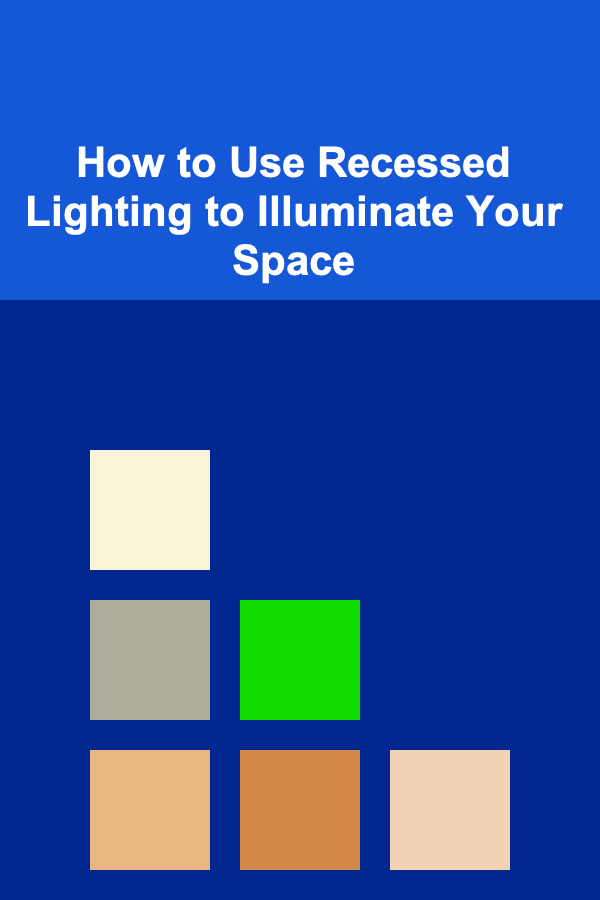
How to Use Recessed Lighting to Illuminate Your Space
ebook include PDF & Audio bundle (Micro Guide)
$12.99$8.99
Limited Time Offer! Order within the next:

Lighting is one of the most important design elements in any space, and choosing the right type of lighting can completely transform the ambiance of a room. One of the most versatile and modern lighting options available is recessed lighting. Recessed lights, also known as can lights or downlights, are installed into the ceiling, offering a clean, streamlined look that provides both functionality and aesthetic appeal.
In this comprehensive guide, we will explore everything you need to know about recessed lighting, including how it works, its benefits, the various types, how to install it, and how to use it effectively in your home. Whether you're looking to illuminate your kitchen, living room, or bathroom, recessed lighting can be an excellent choice to create a bright, welcoming, and visually stunning environment.
What is Recessed Lighting?
Recessed lighting refers to a lighting fixture that is installed into a hollow opening in the ceiling, creating a sleek and unobtrusive look. Unlike traditional light fixtures that hang from the ceiling, recessed lights are flush with the surface, making them a great option for spaces with low ceilings or for those who want a minimalist design.
These lights are commonly used for general, task, or accent lighting, depending on the placement and type of bulb used. Recessed lights are typically used for creating even illumination throughout a room or highlighting specific areas or features in a space.
Components of Recessed Lighting
A recessed light fixture typically consists of three main components:
- Housing: The housing is the part of the recessed light that is installed into the ceiling. It contains the electrical components and is responsible for holding the bulb in place. There are several types of housings designed for different ceiling materials (e.g., drywall, concrete, or wood).
- Trim: The trim is the visible part of the light fixture that is installed around the edge of the housing. It can be used to give the light a finished look and can vary in style, color, and material. Common trim styles include baffle trims (which reduce glare), reflector trims (which direct light in specific directions), and adjustable trims (which allow for directing the light where needed).
- Bulb: The bulb is the actual light source inside the recessed light fixture. There are several options for bulbs, including LED, incandescent, and halogen, with LED bulbs being the most energy-efficient and long-lasting option.
Benefits of Recessed Lighting
Recessed lighting offers several advantages that make it an appealing option for a variety of spaces. Here are some of the key benefits:
1. Aesthetically Pleasing and Discreet
One of the main reasons people opt for recessed lighting is its ability to blend seamlessly into the ceiling. Since the fixtures are installed flush with the surface, they create a clean and modern look without disrupting the visual flow of the room. This makes them ideal for spaces with low ceilings, as they don't take up visual space and can make the room feel more open and expansive.
2. Versatility
Recessed lighting is incredibly versatile and can be used in a variety of ways to suit different lighting needs. It can provide ambient (general) lighting, task lighting (focused light for specific activities), or accent lighting (highlighting key features or artwork). The ability to choose the type of bulb and trim allows for further customization to suit your style and functional requirements.
3. Energy Efficiency
When compared to traditional light fixtures, recessed lights---especially when equipped with LED bulbs---are highly energy-efficient. LED bulbs use significantly less energy than incandescent bulbs, and they have a much longer lifespan, meaning fewer replacements and lower long-term costs.
4. Space Saving
Since recessed lights are installed into the ceiling, they don't take up physical space like pendant lights, chandeliers, or table lamps. This makes them ideal for smaller rooms where floor and ceiling space is limited, or for rooms that require an unobtrusive, minimalist design.
5. Even Illumination
Recessed lighting provides even and consistent illumination throughout the room. Whether used as ambient lighting to fill the room with light or to highlight a specific area, recessed lighting ensures that the light is evenly distributed, eliminating harsh shadows and creating a more pleasant and balanced atmosphere.
Types of Recessed Lighting Fixtures
Recessed lighting comes in several different types, each designed for specific purposes. Understanding these types can help you choose the right recessed lighting for your needs.
1. Fixed Recessed Lighting
Fixed recessed lighting is the most common type and is designed to provide uniform illumination without the ability to adjust the direction of the light. These fixtures are ideal for providing general lighting to a room or for illuminating large areas evenly.
Best for: General lighting in rooms such as living rooms, kitchens, and hallways.
2. Adjustable or Gimbal Recessed Lighting
Adjustable or gimbal recessed lights are designed to be movable, allowing you to change the direction of the light. This flexibility is particularly useful for accent lighting or highlighting specific objects or features, such as artwork, sculptures, or architectural elements.
Best for: Accent lighting, highlighting focal points, and adjustable task lighting.
3. Wall Wash Recessed Lighting
Wall wash recessed lights are designed to cast light over an entire wall, creating a soft, even wash of light that highlights the texture and features of the wall surface. These lights are often used to enhance the visual interest of a room by adding depth and dimension.
Best for: Lighting walls with artwork, textures, or to enhance the overall design of a room.
4. Baffle Recessed Lighting
Baffle recessed lighting has a textured or ribbed trim inside the fixture that helps to reduce glare. The baffle helps soften the light and prevents it from being too harsh, making it ideal for areas where you want a softer, more diffused light.
Best for: Reducing glare in living rooms, bedrooms, or any room where soft lighting is desired.
5. Shower Recessed Lighting
Shower recessed lighting is specially designed for use in damp or wet environments, such as bathrooms or shower areas. These fixtures are built to be moisture-resistant and are often rated for use in wet locations, providing safe and reliable lighting in these spaces.
Best for: Bathrooms, showers, and other areas where moisture or water exposure is common.
6. LED Recessed Lighting
LED recessed lighting fixtures use LED bulbs instead of traditional incandescent or halogen bulbs. These fixtures are known for their energy efficiency, long lifespan, and low heat output. LED recessed lights are available in various sizes, trims, and styles, making them versatile for different applications.
Best for: Energy-efficient, long-lasting lighting for any room in the home.
How to Choose the Right Recessed Lighting for Your Space
Choosing the right recessed lighting for your space involves considering several factors, including the size of the room, the type of lighting you need, and the aesthetic preferences you have for the space. Here are some tips to guide you:
1. Consider the Room Size
The size of the room plays a major role in determining the number and spacing of recessed lights. In general, the larger the room, the more recessed lights you'll need. However, it's important to avoid overlighting, as too many lights can create a harsh and overly bright environment.
For general lighting, aim to place recessed lights about 4 to 6 feet apart in a grid pattern. For task lighting, more focused placement is required.
2. Decide on the Lighting Purpose
Are you using recessed lights for general illumination, accent lighting, or task lighting? The purpose of the lighting will determine the type of fixture and bulb you use. For general lighting, fixed recessed lights with an appropriate bulb will provide even light throughout the room. For accent lighting, adjustable or gimbal recessed lights are ideal for focusing light on specific objects or areas.
3. Choose the Right Trim Style
The trim style of the recessed light affects both the aesthetics and functionality of the light. A baffle trim is ideal for reducing glare, while a reflector trim helps direct the light more efficiently. Consider the overall design of your space and choose a trim style that complements your style while meeting your lighting needs.
4. Opt for LED Bulbs
LED recessed lighting is the most energy-efficient option available. LED bulbs last longer, consume less power, and produce less heat compared to incandescent or halogen bulbs. This makes them an ideal choice for both the environment and your wallet in the long run.
5. Consider Dimming Capabilities
Installing dimmer switches for your recessed lighting can offer greater flexibility in adjusting the light levels to suit different activities or moods. Dimming capabilities are especially useful in spaces like living rooms and bedrooms where the lighting needs may change throughout the day.
Installing Recessed Lighting
Recessed lighting installation can be a DIY project for the experienced home improvement enthusiast, but it's important to ensure that the electrical work is done properly. Here's a basic overview of the installation process:
- Turn Off Power: Always turn off the power at the circuit breaker before working on any electrical components.
- Plan the Layout: Decide on the placement of the recessed lights, keeping in mind the spacing and the overall lighting design.
- Cut the Ceiling Holes: Use a hole saw to cut the correct-sized holes in the ceiling where you want to install the recessed lights.
- Install the Housing: Insert the recessed light housing into the hole and secure it with screws or clips, depending on the model.
- Wiring the Fixture: Connect the electrical wiring to the light fixture according to the manufacturer's instructions.
- Attach the Trim: Once the housing is in place and wired, attach the trim around the edges of the fixture to finish the installation.
- Test the Lights: After installing all the fixtures, turn the power back on and test the lights to ensure they are working properly.
If you're unsure about handling electrical work, it's always best to hire a licensed electrician to install recessed lighting.
Conclusion
Recessed lighting is a highly versatile and effective way to illuminate your space. Whether you're looking to create a modern and clean look, highlight key design features, or simply enhance the functionality of a room, recessed lighting can help achieve your goals. By choosing the right type of recessed lights, properly planning the layout, and understanding how to use them, you can transform your home into a beautifully lit and functional space. Whether you're updating a single room or outfitting your entire house, recessed lighting is an excellent lighting option that can complement any design style.
Reading More From Our Other Websites
- [Home Space Saving 101] How to Design a Multifunctional Living Room in a Compact Space
- [Organization Tip 101] How to Keep Your Entryway Free from Clutter
- [Home Space Saving 101] How to Make the Most of Your Bathroom with Vertical Storage
- [Horseback Riding Tip 101] Saddle‑Ready Style: The Top Must‑Have Pieces for Modern Equestrians
- [Organization Tip 101] What Are the Best Practices for Maintaining Home Organization?
- [Home Soundproofing 101] How to Improve Acoustic Privacy in Shared Living Spaces
- [Organization Tip 101] How to Prepare Your Wardrobe for Seasonal Changes
- [Home Security 101] How to Handle Security Risks in an Urban Environment
- [Home Storage Solution 101] How to Optimize Home Office Organization: Create a Productive Workspace
- [Organization Tip 101] How to Incorporate Movement with Organized Exercise Equipment

How to Choose the Best Pet Bed for Your Furry Friend
Read More
How to Organize Digital Copies of Important Documents
Read More
How to Organize Your Laundry Room for Efficient Storage
Read More
How to Tidy Your Home and Save Space with Minimalist Decor
Read More
How to Use Financial Modeling to Make Money
Read More
Understanding Your Camera's Settings: A Comprehensive Guide
Read MoreOther Products

How to Choose the Best Pet Bed for Your Furry Friend
Read More
How to Organize Digital Copies of Important Documents
Read More
How to Organize Your Laundry Room for Efficient Storage
Read More
How to Tidy Your Home and Save Space with Minimalist Decor
Read More
How to Use Financial Modeling to Make Money
Read More